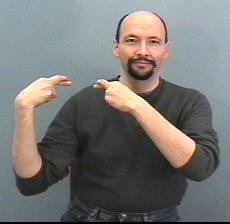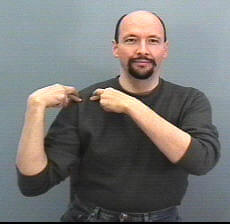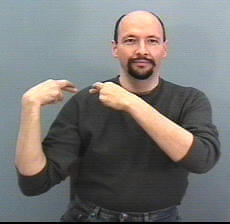American Sign Language: "responsible"
RESPONSIBLE:
Touch the tips of "bent hands" to your shoulder either once or twice.
(Note: This sign doesn't need to be done with "R" hands.)
Usage note: You will see this done with either a single or a double movement.
I tend to see the "double" movement for the concept "responsibility." As in "It is your responsibility."
I tend to use a single, longer contact when signing things such as, "You are responsible for the result." (Memory tip, "The weight of this situation is on your shoulders."
There is an initialized version of the sign "RESPONSIBLE" that is fading out. It really isn't necessary to initialize this sign for the meaning to be clear. I suppose it might be helpful to know the initialized version if for some reason you need to differentiate between "accountable" and "responsible." But realistically the sign works fine with bent hands instead of "R" hands.
RESPONSIBLE (initialized version) (no longer recommending this version)
OPTIONAL READING / NOT REQUIRED FOR CLASS
In a message dated 2/7/2012 7:29:32 P.M. Pacific Standard Time, Mian writes:Why do you sign "responsible" with "R" hands? Isn't that awfully English? I am an ASL 6 student, and root out English whenever we can. It's drilled into us. Lots of lexicalized words are losing their "letter" handshape. I learned responsible with bent =B hands...ummm maybe open bent B hands. Love your site, use it ALL the time.- MianDear Mian,Eh? Perhaps you are looking at an old page?
If so, you need to update your page:http://lifeprint.com/asl101/pages-signs/r/responsible.htm
(Let me know if you and I are seeing the same thing. On that page you'll note that I list the bent-hand version at the top of the page and make a special point of mentioning that it doesn't need "R" hands.)
Ahem, no, I don't think that "R" hands on "responsible" is "awfully" English.
I think that many years ago when I first posted the "R" version it was a "non-issue."
I think several years ago it was a "tad" English.
I think a year or so ago it was "a bit too" English
I think currently it is "significantly" English, (and that significant portion of the rank and file Deaf community still use the "R" hand version).
I think later this year it will be "annoyingly" English.
But I don't think we are going to hit "awfully" English for at least another year.
You may be amused to learn that my wife, Belinda, hasnaggedum helpfully mentioned to me about that same page since last year which is why I added the bent hand version at the top.
And, for what it is worth, as a result of yournaggingum, I mean thoughtfully pointing out that "lots of lexicalized words are losing their letter handshapes" (somewhat like regaining their virginity I would suppose) I will probably soon be updating that page again so as to properlydrill it into the heads of, um I mean help people understand that ASL, like all living languages, changes and morphs over time.
Most cordially,Dr. Bill
A student asks:
"What is the difference between using the sign for "blame, accuse" to indicate "fault" versus the sign where the hand drops down from "responsibility"? Do either of these signs represent the concept of ‘having many faults' (shortcomings)? Thanks for your help!" - Linda
Dear Linda,
The "BLAME" sign can mean "accuse," "It is your/my/his/her/its fault" or "blamed." This sign is directional thus it can indicate who or what is "at fault" or who is being "accused" as well as who is doing the accusing. See: BLAME
The "FAULT" sign is non-directional and needs a sign such as "YOUR," "MY," or "HIS/HER" to indicate the object. This sign cannot be used directly to indicate "accusation." You would need to sign, "SHE INFORM-me your-FAULT" or "SHE TOLD-me YOUR FAULT."
FAULT:
Here's a view of the sign "FAULT" from an angle:
Also see: FAULT
"Shortcomings" would not use the sign "FAULT." Shortcomings would be described with phrases such as:
"HE/SHE PROBLEMS MANY!"
"HE/SHE WEAK MANY!"
"HIS/HER CHARACTER? SO-SO."
"HE/SHE not-GOOD-ENOUGH."
Such phrases would be accompanied by non-manual markers (facial expressions/body language) such as a "scrunched nose."
-- Dr. Bill
Linda writes:
"Ok, so besides one sign being directional and one needing a possessive pronoun both signs mean the same thing?"
Linda,
No. Each sign has its own semantic range (a range of meanings). The semantic ranges of the two signs do overlap, but not completely.
If you look the words up in an English dictionary you will note that the word "fault" has about twice as many meanings as the word "blame."
The ASL sign FAULT only expresses two or three of the meanings of the word "fault."
The meanings of the word "blame" generally contain the concept of "to" as in "to find fault," "to accuse," "to attribute."
I generally think of the ASL sign "FAULT" as being limited to meaning "responsibility for some negative occurrence or situation."
The ASL sign BLAME carries a wider semantic range than the ASL sign "FAULT."
- Dr. Bill
You can learn American Sign Language (ASL) online at American Sign Language University ™
ASL resources by Lifeprint.com © Dr. William Vicars
Want to help support
ASL University? It's easy:
DONATE (Thanks!)
(You don't need a PayPal account. Just look for the credit card
logos and click continue.)
Another way to help is to buy something from the ASLU "Bookstore."
Want even more ASL resources? Visit the "ASL Training Center!" (Subscription
Extension of ASLU)
CHECK IT OUT >
Bandwidth slow? Check out "ASLUniversity.com" (a
free mirror of
Lifeprint.com less traffic, fast access)
VISIT >









